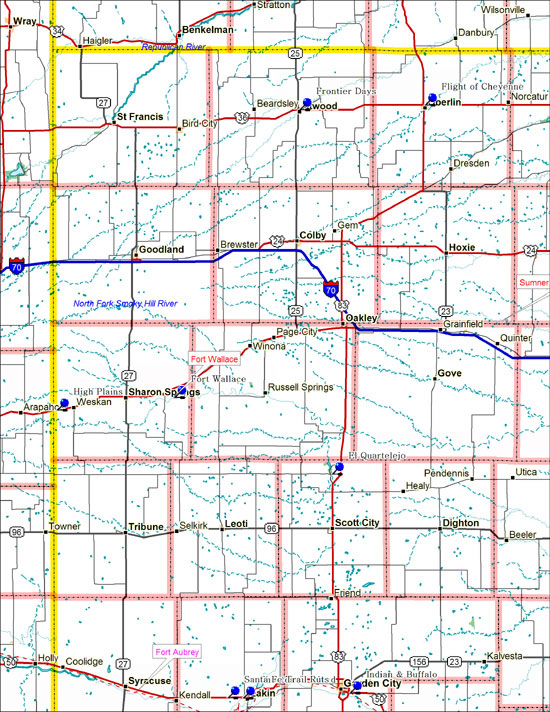|
||||
|
|
||||
Choteau's IslandMarker Topic: Choteau's Island El QuartelejoMarker Topic: El Quartelejo Flight of the CheyenneMarker Topic: Flight of the CheyenneAddress: US-36, Roadside turnout, northeast of Oberlin City: Oberlin County: Decatur Marker Text: After the Little Bighorn battle in 1876, the U.S. government forced most Northern Cheyennes from the Northern Plains to a reservation in Indian Territory, present-day Oklahoma. In September 1878 a group led by Chiefs Dull Knife and Little Wolf attempted to return to their homeland. Angry and embittered by their plight, they killed settlers and herders as they fled through Kansas. Frontier Days in RawlinsMarker Topic: Frontier Days at RawlinsAddress: Lake Road and Second Street, Lake Atwood City Park City: Lake Atwood County: Rawlins Marker Text: Travel is so smooth and effortless today that it is hard to visualize its hazards in the mid-19th century. For example, in June 1859, four mules pulling a Denver-bound Pike's Peak Express stagecoach--six days and 450 miles out from Leavenworth --were terrified by Indians a few miles northeast of Here. Plunging down a precipitous bank, the animals upset the coach and its best-known passenger, Horace Greeley, editor of the New York Tribune. High PlainsMarker Topic: High PlainsAddress: US-40, Roadside turnout, Kansas-Colorado state line City: County: Wallace Marker Text: Here on the western border of Kansas is the heart of yesterday's buffalo and Indian country. Until the 1870s millions of buffalo grazed these plains, and in this area were fought some of the last battles between Indians and whites. Troops stationed at Fort Wallace, 25 miles east, patrolled the frontier and participated in many skirmishes with hostile warriors. Indian and the BuffaloMarker Topic: Indian and the BuffaloAddress: US-50, Roadside turnout; East city limits of Garden City City: Garden City County: Finney Marker Text: The buffalo was the department store of the Plains Indian. The flesh was food, the blood was drink, skins furnished wigwams, robes made blankets and bed, dressed hides supplied moccasins and clothing, hair was twisted into ropes, rawhide bound to hold to handles, green hides made pots for cooking over buffalo-chip fires, hides from bulls' necks made shields that would turn arrows, ribs were runners for dog-drawn sleds, small bones were awls and needles, from hooves came glue for feathering arrows, from sinews came thread and bowstrings, from horns came bows, cups and spoons, and even from gall stones a "medicine" paint was made. NicodemusMarker Topic: Nicodemus Santa Fe Trail Ruts 1821-1872Marker Topic: Santa Fe Trail RutsAddress: US-50, Roadside turnout, 4 miles east of Lakin City: Lakin County: Kearny Marker Text: Looking east, up and over the bank of the ditch, one can see the wagon ruts of the Santa Fe Trail. You will notice a difference in the color and texture of the grass in the ruts. This is a characteristic of the ruts along the trail. Fort WallaceMarker Topic: Fort WallaceAddress: US-40, Fort Wallace Museum City: Wallace County: Wallace Marker Text: First called Camp Pond Creek, Fort Wallace was established in 1865. The fort served as the headquarters for troops given the task of protecting travelers headed west along the Smoky Hill Trail to the Denver gold fields. |
||||
|
||||
